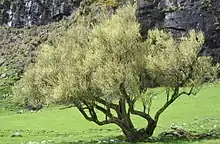Stathmopoda campylocha
Stathmopoda campylocha is a species of moth in the family Stathmopodidae. It is endemic to New Zealand. It is classified as critically endangered by the Department of Conservation.
| Stathmopoda campylocha | |
|---|---|
 | |
| Scientific classification | |
| Kingdom: | |
| Phylum: | |
| Class: | |
| Order: | |
| Family: | |
| Genus: | |
| Species: | S. campylocha |
| Binomial name | |
| Stathmopoda campylocha | |
Taxonomy
This species was first described by Edward Meyrick in 1889 using specimens collected in Wellington and Dunedin in January.[3][4] The type specimen is held at the Natural History Museum, London and the type locality is recorded as being "Dunedin, New Zealand".[3]
Description
Meyrick described the species as follows:
12-14mm. Head and thorax whitish-ochreous, somewhat metallic-shining. Palpi and antennae pale whitish-ochreous. Abdomen grey. Legs whitish-ochreous, greyish-tinged, anterior pair dark grey, posterior tibiae with dark-grey scales at origin of spurs. Forewings elongate, very narrow, broadest near base, long-pointed ; whitish-ochreous ; an ochreous-fuscous or dark fuscous streak along costa from base to 3⁄4, sometimes almost obsolete ; an ochreous-fuscous or dark fuscous broadly V-shaped mark before middle, more or less suffused, variable in thickness, its angle resting on inner margin, extremities nearly reaching costa ; a longitudinal line in posterior half of disc, a spot at apex, and an elongate spot at anal angle ochreous-fuscous or ochreous, sometimes partially connected : cilia grey. Hindwings rather dark grey ; cilia grey.[4]
Distribution
This species is endemic to New Zealand.[2][5] Historically this species occurred at Wellington and Dunedin,[6] and in 1915 Charles E. Clarke collected a specimen in mid December at Silverstream, Upper Hutt.[7] A further specimen was collected in early February in 1932 in the Pohangina Forest Reserve and was used by George Vernon Hudson to create an illustration of the species.[8] In more recent times S. campylocha has been found to be present in western and eastern Otago including in the Matukituki Valley.[9][10]
Ecology and habitat
Meyrick collected his specimens amongst forest[4] and Hudson concurred that the species frequents forest habitat.[6]
Host species

In 2000 Brian H. Patrick discovered that S. campylocha is associated with the nationally endangered plant Olearia hectorii.[9][10] Patrick was unable to locate S. campylocho larvae feeding but he hypothesised that they are likely detritivores or alternatively that they feed on scale insects.[9] He also suggested other possible host plants might be Olearia fimbriata, Olearia lineata, Olearia bullata or Olearia fragrantissima.[9] Plant-SyNZ indicates Olearia virgata as another possible host plant, attributed to Patrick (2000).
Conservation Status
In 1939 Hudson stated that S. campylocha was regarded as being extremely rare.[8] This species has been given the "Nationally Critical" conservation status under the New Zealand Threat Classification System.[1]
References
| Wikispecies has information related to Stathmopoda campylocha. |
- Hoare, R.J.B.; Dugdale, J.S.; Edwards, E.D.; Gibbs, G.W.; Patrick, B.H.; Hitchmough, R.A.; Rolfe, J.R. (2017). "Conservation status of New Zealand butterflies and moths (Lepidoptera), 2015" (PDF). New Zealand Threat Classification Series. 20: 6.
- "Stathmopoda campylocha Meyrick, 1889". www.nzor.org.nz. Landcare Research New Zealand Ltd. Retrieved 2018-04-29.
- Dugdale, J. S. (1988). "Lepidoptera - annotated catalogue, and keys to family-group taxa" (PDF). Fauna of New Zealand. 14: 108. Retrieved 1 May 2018.
- Meyrick, Edward (1889). "Descriptions of New Zealand Micro-lepidoptera". Transactions and Proceedings of the New Zealand Institute. 21: 154–188. Retrieved 1 May 2018 – via Biodiversity Heritage Library.
- Gordon, Dennis P., ed. (2010). New Zealand inventory of biodiversity. Volume two. Kingdom animalia : chaetognatha, ecdysozoa, ichnofossils. Vol. 2. Christchurch, N.Z.: Canterbury University Press. p. 463. ISBN 9781877257933. OCLC 973607714.
- Hudson, G. V. (1928). The Butterflies and Moths of New Zealand. Wellington: Ferguson & Osborn Ltd. p. 299.
- "Stathmopoda campylocha". www.aucklandmuseum.com. Auckland War Memorial Museum. Retrieved 1 May 2018.
- Hudson, George Vernon (1939). A supplement to the butterflies and moths of New Zealand. Wellington: Ferguson & Osborn Ltd. p. 456.
- Patrick, Brian (2000). "Lepidoptera of small-leaved divaricating Olearia in New Zealand and their conservation priority" (PDF). Science for Conservation. New Zealand Department of Conservation. 168: 1–26. ISSN 1173-2946. OCLC 48661253. Retrieved 1 May 2018.
- Mt Aspiring Station Conservation Resources Report Part 1 (Report). Department of Conservation. November 2005. pp. 1–62. Retrieved 2 May 2018.
